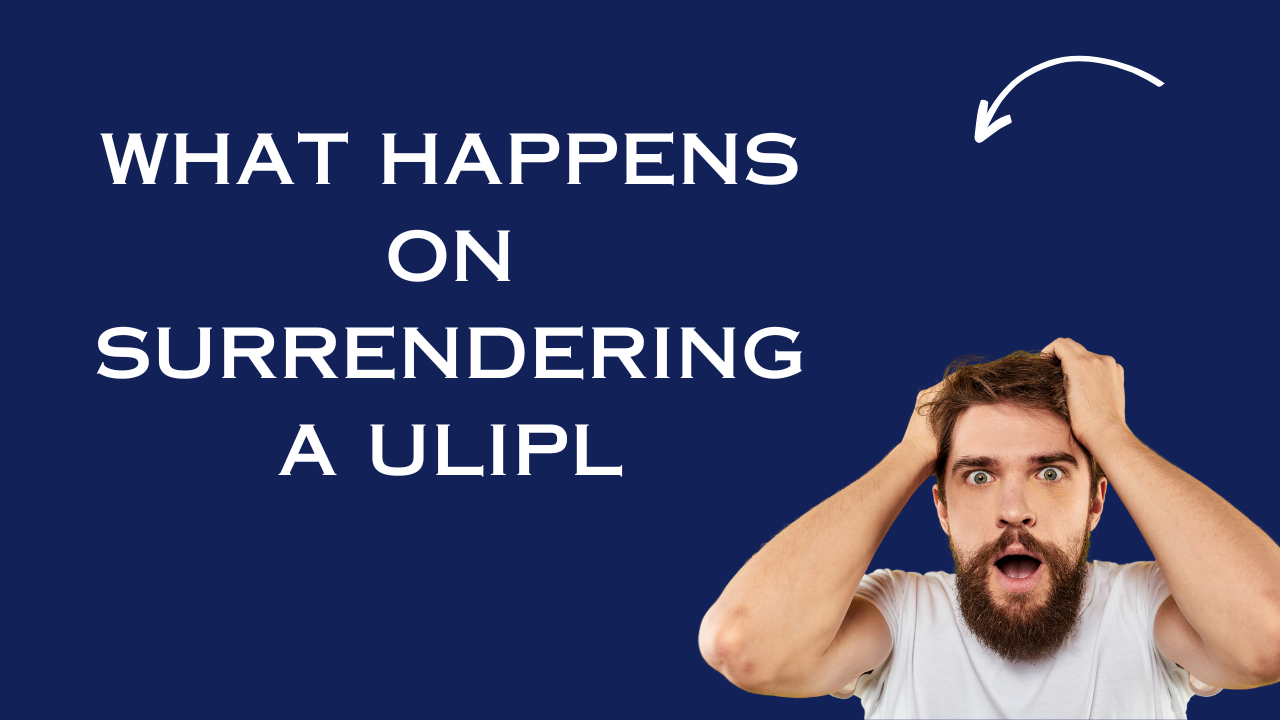Surrendering a ULIP refers to the process of terminating the unit-linked insurance plan before its original maturity date. When a policyholder decides to surrender a ULIP, they essentially exit the policy, and the insurance coverage and investment components come to an end. Surrendering a ULIP means surrendering both the life insurance coverage and the investment component associated with the policy.
Surrender Value Calculation:
The surrender value of a ULIP is the amount that the policyholder receives upon surrendering the policy before its maturity date. It represents the current value of the policy after deducting surrender charges, if applicable. The surrender value is different from the maturity value, which is the total value of the policy when it reaches its original maturity date.
The calculation of the surrender value involves several factors:
- Premium Paid: The total amount of premiums paid by the policyholder during the policy term is considered in the calculation. If the ULIP has been held for a considerable period, a significant portion of the premiums may have gone towards various charges and fees, impacting the surrender value.
- Policy Term: The duration for which the ULIP has been held also affects the surrender value. The longer the policy has been in force, the higher the potential for the surrender value to increase.
- Investment Performance: ULIPs invest a portion of the premium in various market-linked funds. The investment performance of these funds significantly impacts the surrender value. Positive investment performance may increase the surrender value, while negative performance may decrease it.
- Surrender Charges: Many ULIPs have surrender charges, especially during the initial policy years. These charges are levied as a percentage of the premium paid and reduce the surrender value.
- Mortality Charges: Mortality charges are deducted to provide the life insurance coverage, and they can impact the surrender value, particularly in the early policy years.
- Policy Fees: Various administrative and fund management fees are deducted from the premium, which can influence the surrender value.
- Fund Switching Charges: If the policyholder has availed fund switching options during the policy term, any applicable charges for these switches may be deducted from the surrender value.
Surrender Charges:
Surrender charges are fees or penalties imposed by the insurance company when a policyholder decides to surrender or terminate a ULIP before its maturity date. These charges are deducted from the policy’s surrender value, which is the amount the policyholder receives upon surrendering the policy.
Key points regarding surrender charges in a ULIP:
- Initial Surrender Charge: Most ULIPs have higher surrender charges in the initial years of the policy. These charges are designed to recover the costs incurred by the insurance company in issuing the policy.
- Declining Surrender Charges: Surrender charges usually decrease over time, typically reaching zero after the lock-in period. The lock-in period is the minimum duration for which the policy must be held before it can be surrendered without incurring surrender charges.
- Lock-in Period: The lock-in period for ULIPs is generally five years. During this period, surrendering the policy will attract higher surrender charges.
- Surrender Charge Structure: The surrender charge structure varies among insurance companies and ULIP plans. It is essential for policyholders to review the policy document to understand the specific surrender charge schedule.
- Impact on Surrender Value: Surrender charges can significantly impact the final surrender value received by the policyholder. The higher the surrender charges, the lower the surrender value after deductions.
- Surrender Charge Waiver: Some ULIPs may offer a surrender charge waiver after a certain number of years. This means that after a specific period, surrendering the policy will not incur any charges.
- Tax Implications: Surrender charges are not tax-deductible, and the amount deducted from the surrender value may have tax implications for the policyholder.
Surrender Process and Documentation:
The process of surrendering a ULIP typically involves the following steps:
- Contact the Insurance Company: The policyholder should initiate the surrender process by contacting the insurance company or their designated agent. They can inquire about the specific surrender charge, surrender value, and the necessary documentation.
- Submission of Surrender Request: The policyholder needs to submit a surrender request to the insurance company in writing. The request should include essential details, such as the policy number, policyholder’s details, and reason for surrendering.
- KYC and Identity Verification: The insurance company may require the policyholder to complete Know Your Customer (KYC) formalities, including submitting identity and address proof documents.
- Surrender Form: The insurance company may provide a surrender form that the policyholder needs to fill out and sign. This form serves as a formal request for surrendering the policy.
- Submission of Documents: The policyholder should provide any additional documents requested by the insurance company, such as a cancelled policy bond and a bank mandate form for transferring the surrender value.
- Surrender Value Calculation: Upon receiving the surrender request and all necessary documentation, the insurance company will calculate the surrender value and inform the policyholder.
- Processing Time: The processing time for surrendering a ULIP may vary among insurance companies. Once the surrender value is calculated, the payment is made to the policyholder via cheque or bank transfer.
Tax Implications on Surrender:
Surrendering a ULIP may have tax implications for the policyholder, particularly on the gains realized from the investment component of the policy. The tax treatment depends on the duration for which the policy was held and whether it qualifies for tax exemptions under the prevailing tax laws.
- Short-Term Surrender (Held for Less Than 5 Years): If the policyholder surrenders the ULIP before completing five years from the commencement date, any gains from the investment component will be considered as Short-Term Capital Gains (STCG). STCG is added to the policyholder’s taxable income for the financial year of surrender and is taxed as per the individual’s income tax slab rate.
- Long-Term Surrender (Held for 5 Years or More): If the policy is held for five or more years, the gains from the investment component will be treated as Long-Term Capital Gains (LTCG). LTCG on ULIPs is subject to a special tax treatment as per Section 10(10D) of the Income Tax Act. Any gains realized upon surrender after five years are tax-exempt, and the entire amount is tax-free in the hands of the policyholder.
Surrendering During Market Fluctuations:
The decision to surrender a ULIP during market fluctuations can significantly impact the surrender value received by the policyholder. Market fluctuations can lead to fluctuations in the value of the investment component of the ULIP. Surrendering during a market downturn may result in a lower surrender value compared to a market upturn.
Here are some considerations when surrendering a ULIP during market fluctuations:
- Market Timing Risk: Surrendering a ULIP during a market downturn may lead to realizing losses on the investment component. If the policyholder can hold the ULIP for an extended period, they may have the opportunity to recover from market downturns and benefit from potential market upturns.
- Surrender Charges: Surrendering during market fluctuations may coincide with higher surrender charges, especially if the ULIP is still within the lock-in period. Considering the impact of surrender charges on the final surrender value is crucial before making a decision.
- Long-Term Perspective: ULIPs are designed as long-term investment-cum-insurance products. Surrendering during market fluctuations may undermine the original long-term financial goals and objectives for which the policy was purchased.
- Reinvestment Risk: After surrendering the ULIP, the policyholder may need to find alternative investment options for the surrender value. Reinvesting during uncertain market conditions may pose its own set of risks.
FAQs about Surrendering a ULIP:
- Can I surrender a ULIP at any time?
- Yes, you can surrender a ULIP at any time during the policy term. However, surrendering before the completion of the lock-in period (usually five years) may incur higher surrender charges.
- How are surrender charges calculated?
- Surrender charges are calculated as a percentage of the premium paid and vary based on the policy’s terms and conditions. The charges are typically higher in the initial policy years and gradually decrease over time.
- What happens if I surrender a ULIP before the lock-in period ends?
- Surrendering a ULIP before the lock-in period ends may result in higher surrender charges, reducing the surrender value. Additionally, the gains on the investment component may be subject to taxation as Short-Term Capital Gains.
Conclusion:
Surrendering a ULIP is a significant decision that requires careful consideration of the surrender charges, tax implications, and the impact on the financial plan. While surrendering a ULIP may provide immediate liquidity, it may result in the loss of insurance coverage and may not be the most suitable option for long-term financial goals.
Read More:
- Post Office Savings Account: Benefits and How to Open an Account
- 7 Simple Ways to Start Saving for a Bright Future
- How can I grow my savings fast?
- Saving Account: Types, Interest rates, and eligibility criteria




